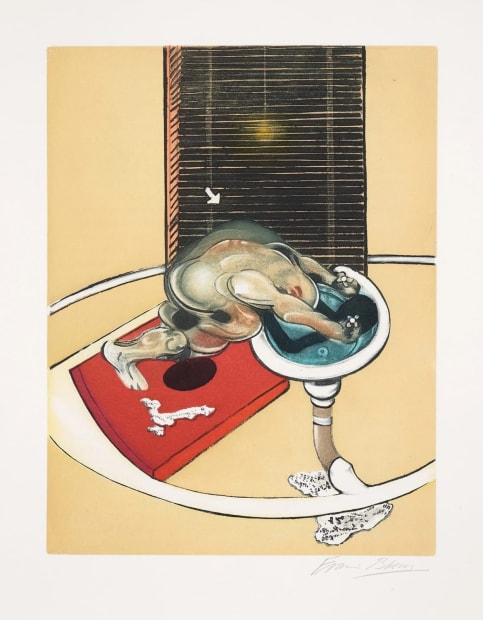-

-
after Figure at a Washbasin (1976)
“I believe in deeply ordered chaos. I want a very ordered image but I want it to come about by chance. If you want to convey fact, this can only ever be done through a form of distortion.”
After Figure at a Washbasin (1976) is an etching and aquatint in colours by Francis Bacon created between 1977 and 1978, epitomises Bacon's distinct approach to exploring the human condition through distortion, anguish, and raw physicality. As one of the few etchings Bacon personally worked on before its completion by a master printer under his supervision, this work carries a heightened sense of his direct engagement with the subject matter, making it a compelling piece within his broader oeuvre.
The composition presents a solitary, contorted figure grasping the edges of a washbasin, a stance that suggests an act of desperation or a search for solace. The figure's distorted and muscular form, rendered with sweeping, almost violent strokes, is characteristic of Bacon’s style, where the human body is often twisted into positions that evoke vulnerability, torment, and existential struggle. The man’s body seems almost boneless, with a fluidity that hints at transformation or disintegration, reflecting Bacon's ongoing fascination with the malleability and fragility of the human form.
Bacon's use of distortion in this piece goes beyond mere physicality—it taps into deeper psychological themes. The washbasin, often associated with cleansing or purification, here becomes a site of struggle, as if the figure is trapped in an endless cycle of trying to cleanse himself of something intangible. This sense of entrapment and internal conflict is heightened by the circular composition framing the figure, which could suggest a feeling of confinement or being stuck in an existential loop. The circular elements, combined with the figure’s hunched posture, create a claustrophobic atmosphere, which is a hallmark of Bacon's work. His figures are often depicted in enclosed spaces, emphasising the sense of isolation and anxiety that permeates his vision of the human experience.
The contrasting colours, from the muted, fleshy tones of the figure to the stark red surface upon which he kneels, add to the work’s tension. The red rectangle beneath the figure is reminiscent of an altar or a stage, suggesting that the figure's struggle is both a private agony and a public spectacle, a theme recurrent in Bacon’s works. This blending of public and private torment, the sense that suffering is both intensely personal yet universally visible, is central to Bacon's exploration of the human condition.
Furthermore, the subtle inclusion of the skeletal fragments on the floor, as well as the ambiguous objects in the background, evokes a sense of mortality and decay, reinforcing the existential themes of Bacon’s work. It’s as if the figure’s struggle at the washbasin is not just physical but symbolic of a broader confrontation with death, despair, and the transience of life. This motif aligns with Bacon's larger body of work, where he frequently depicted bodies in states of disintegration or dissolution, challenging the boundaries between flesh and spirit, life and death.
In the broader context of Bacon’s career, after Figure at a Washbasin (1976) reflects his obsession with depicting the psychological trauma and anxieties of post-war Europe, as well as his own personal demons. Unlike many of his works, which often feature multiple figures or are presented as part of a triptych, this piece focuses on a single individual, heightening the sense of isolation and personal suffering.
The figure’s grotesque, yet strangely beautiful, form reflects Bacon's interest in capturing the raw, unfiltered reality of existence. It is not the idealised human body but one that is battered, distorted, and marked by the weight of its own experiences. This portrayal is deeply rooted in Bacon’s fascination with existentialism and the works of philosophers like Nietzsche, who pondered the chaotic, often painful nature of life. The man's futile grasping at the washbasin suggests an unending quest for meaning or redemption, an effort that is ultimately in vain but nonetheless profoundly human.
-
-
Buy or sell L'homme au Lavabo by Francis Bacon at Andipa Editions
Buy Francis Bacon L'homme au Lavabo
Andipa Editions, as part of Andipa, have been at the forefront of the Bacon market for over 25 years. To enquire about buying Francis Bacon L'homme au Lavabo, contact us via sales@andipa.com or on +44 (0) 20 7589 2371.
Sell Francis Bacon L'homme au Lavabo
With a global network of active buyers, Andipa Editions are the place to sell your L'homme au Lavabo print. Straight-forward and stress-free, we manage the process on your behalf and help to maximise your return. For a complimentary valuation of your L'homme au Lavabo print, contact us via sales@andipa.com or on +44 (0) 20 7589 2371. Explore our collection of Francis Bacon prints for sale.
